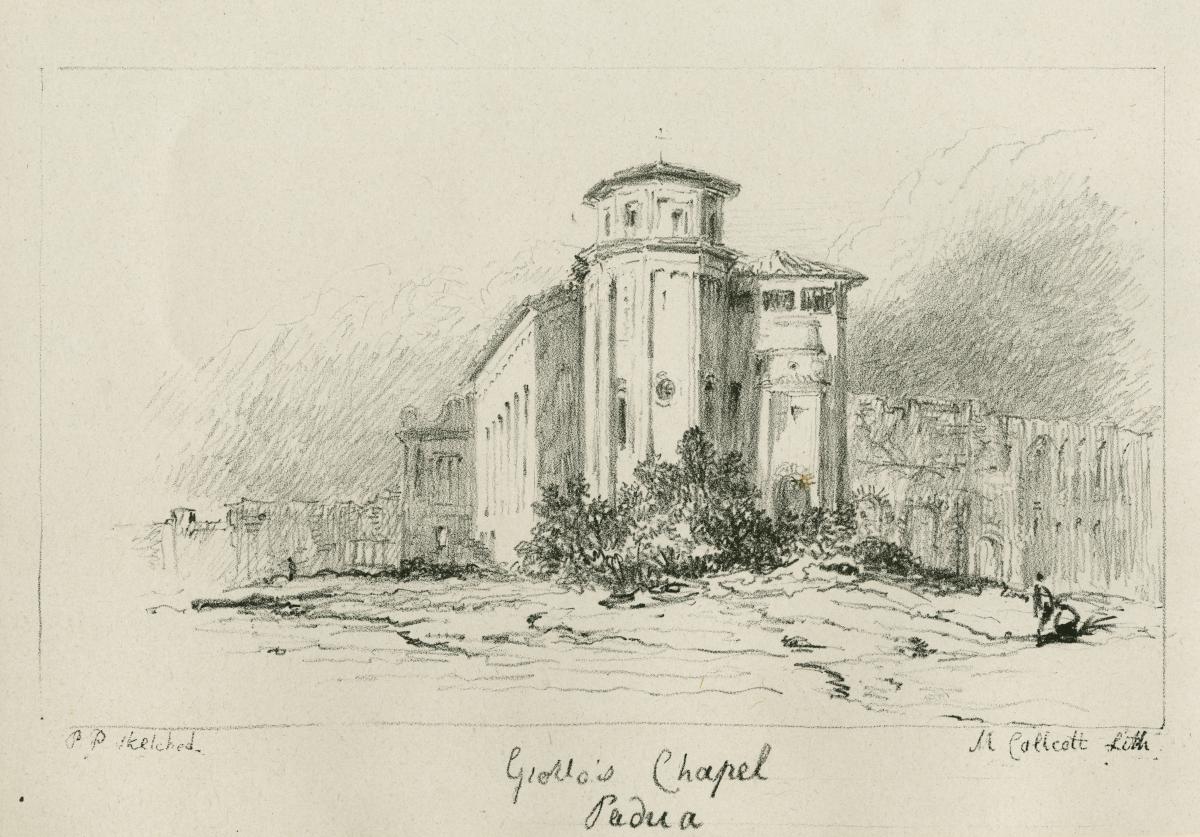The art historian, author, and traveller Maria Callcott was born on 19 July 1785. Together with her husband, the Royal Academician Sir Augustus Wall Callcott (1779-1884), in 1827 she made an extensive honeymoon tour of the art galleries and churches of Italy, Germany, France, Austria, and Bavaria. They paid particular attention to the art of the early Italian, French, and Netherlandish Old Masters.
The couple’s travel journals contain extensive notes, demonstrating their marked interest in artists working before the Renaissance. Described in Britain as the ‘primitives’, this appreciation of painters such as Giotto (1267–75-1337) and Altichiero (1369-1393) was unusual for the time. The contemporary attitude saw such artists and artworks as stylistically inferior and ugly, an awkward stage in the development of Italian art before flourishing in the High Renaissance, reaching its pinnacle in the perfection of Raphael.
One of the most important works to come out of the couple’s travels was the Description of the Chapel of the Annunziata dell’Arena; or, Giotto’s Chapel, in Padua. Published in 1835, this is the first English-language account of this major fresco cycle.
The Arena Chapel frescoes marks a major shift in the development of Italian art, from an earlier style drawing heavily on Byzantine icon models towards a greater realism and naturalism in the depiction of the human figure, emotion and action. In 1300, Enrico Scrovegni purchased the site of the old Roman Arena, or theatre, in Padua, on which his family’s palace and chapel was constructed. Commissioning Giotto for the frescoes, these were executed between 1303-05 and the chapel became a major centre of civic and religious life of Padua.
The Callcott’s publication was a collaborative venture, featuring a descriptive essay by Maria and illustrations by augustus, both of which were based on notes and drawings the couple made on the spot during their visit to the chapel in November 1827.
Maria praised the frescoes as works of aesthetic beauty in their own right, describing the Arena as a ‘monument of the spirit of early artists’. She also voiced her concern over the condition of the frescoes and her motivation for publishing such a book as an attempt to record and preserve them in the face of their deterioration.
The publication also provided extensive descriptions of other important frescoes and artworks in Padua, including those of the Eremitani Chapel by Andrea Mantegna and Guariento; Giotto’s work in the Salone, or Town Hall, of Padua; and works of art in the Church of St. Anthony.
As Francis Haskell has described, Maria Callcott’s “response to art was exceptional in its range and perception” and in her appreciation of “primitive” Italian art beyond a mere historical curiosity; as a result, she effected a major contribution to the development of taste in early nineteenth-century Britain.
Maria Callcott signed and donated a copy of the Description to the Royal Academy’s Art Library, where it has been digitised as part of a major project.
References:
Callcott, Maria. Description of the Chapel of the Annunziata dell’Arena; or, Giotto’s Chapel, in Padua. London: 1835, privately printed.
Collier, Carly. “Maria Callcott, Queen Victoria and the “Primitives””. Visual Resources 33, no. 1-2: Special Issue: Women’s Expertise and the Culture of Connoisseurship (2017): 27-47.
Haskell, Francis. Rediscoveries in Art: Some Aspects of Taste, Fashion and Collecting in England and France. Oxford: Phaidon, 1980.
Jacobus, Laura. Giotto and the Arena Chapel: Art, Architecture and Experience. London; Turnhout: Harvey Miller Publishers, 2008.
Mitchell, Rosemary. “Callcott , Maria, Lady Callcott (1785–1842).” Rosemary Mitchell In Oxford Dictionary of National Biography, edited by H. C. G. Matthew and Brian Harrison. Oxford: OUP, 2004. Online ed., edited by David Cannadine, October 2009. http://www.oxforddnb.com/view/article/4399(accessed July 10, 2017).
Palmer, Caroline. “‘“I Will Tell Nothing That I Did Not See”: British Women’s Travel Writing, Art and the Science of Connoisseurship, 1776–1860.” Forum for Modern Language Studies 51, no. 3 (2015).
Richards, John C.. “Giotto di Bondone.” The Oxford Companion to Western Art. Oxford Art Online. Oxford University Press, accessed July 10, 2017, http://www.oxfordartonline.com/subscriber/article/opr/t118/e1049.
Further reading:
Brown, D. B. and C. Lloyd eds. The Journal of Maria, Lady Callcott, 1827-8. 1981.
Collier, Carly. “From “Gothic Atrocities” to Objects of Aesthetic appreciation: The Transition from Marginal to Mainstream of Early Italian Art in British Taste During the Long Eighteenth Century.” In The Centre and the Margins in Eighteenth-Century British and Italian Cultures, edited by Frank O’Gorman and Lia Guerra, 117-130. Newcastle upon Tyne, UK: Cambridge Scholars Publishing, 2013.
Collier, Carly, and Caroline Palmer. Discovering Ancient and Modern Primitives: The Travel Journals of Maria Callcott, 1827-28. Walpole Society Journal. Vol. 78, 2016.
Gotch, R. B., Maria, Lady Callcott: the creator of ‘Little Arthur. London: John Murray, 1937.
Sir Augustus Wall Callcott, Lady Maria Callcott, née Dundas (1785-1842), oil on canvas, about 1830, 107 x 78, Government Art Collection.
Title page to Maria Callcott, Description of the Chapel of the Annunziata dell’Arena; or, Giotto’s Chapel, in Padua. London: 1835. © Royal Academy of Arts, London.
Maria Callcott, Giotto’s Chapel, Padua, lithograph frontispiece to Description of the Chapel of the Annunziata dell’Arena; or, Giotto’s Chapel, in Padua. London: 1835. © Royal Academy of Arts, London.
Interior view of the Cappella Scrovegni (Arena Chapel), Padua.
Illustration from Maria Callcott, Description of the Chapel of the Annunziata dell’Arena; or, Giotto’s Chapel, in Padua. London: 1835. © Royal Academy of Arts, London.
Detail from the Marriage of the Virgin, 1303-5, fresco, Cappella Scrovegni (Arena Chapel), Padua.






